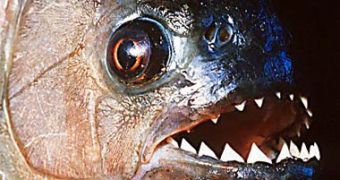There are much bigger fishes in the river than this rather small guy, that do not pass over 42 cm (1.2 ft) in length and 3.85 kg (9 pounds) in weight, that trigger the dread in any traveler through South America. Their image is horrific, with a mouth full of razor-sharp 4 mm long canine-like teeth, which are replaced constantly during their lifespan just as in the case of the sharks and crocodiles. The shoal attack can clean off meat from a smaller carcass in several minutes.
But a new research shows that their fearsome reputation precedes the reality. Piranhas seems to be rather fearful creatures, that gather in large shoals to protect themselves from predators. "Rather than aggressive killers, research shows piranhas are omnivorous scavengers, eating mainly fish, plants and insects," said Anne Magurran of Scotland's University of St Andrews.
Piranhas do have a keen sense of smell and hearing and can pick up a drop of blood in 200 liters of water, but have poor eyesight.
The piranhas of the genus Catoprion do not kill at all. They "graze" on their prey, usually just taking a bite out of another fish's fins or scales. The flesh grows back within weeks, giving them the chance to feast on the same victim again. The meat-eating killers belong to the genera Serrasalmus, Pygopristis and Pygocentrus.
"Previously it was thought piranhas shoaled as it enabled them to form a cooperative hunting group. However, we have found that it is primarily a defensive behavior. Their cautious behavior is crucial to avoid being eaten," she said.
In fact, many people ignore the fact that locals find piranha meat as one of the best amongst Amazon's fish. The same idea is shared on many predators, from boto (the Amazon river dolphin) to giant otters, caymans (a relative of the alligators), birds (like herons) to and bigger fish, like the giant pirarucu (Arapaima gigas), considered the largest freshwater fish in the world (over 3 m (10 ft) long and 200 kg (440 pounds) heavy).
Working at the Mamiraua Institute in Brazil, Magurran revealed how shoal sizes increase in connection to predation risk, especially when water levels in the Amazon basin drop, leaving less room for piranhas to escape attack. The piranha shoals have a typical pattern, with the larger adult individuals in the middle, surrounded by smaller juveniles.
"Previously it was thought piranhas shoaled as it enabled them to form a co-operative hunting group. However we have found that it is primarily a defensive behavior, and quite a complex one. The bigger, older fish tend to swim in the middle as they are reproductively mature and need to keep safe, whereas the outer layer of the shoal is made up of smaller, younger piranhas. Being at the edge of the group means they can get access to food sooner - essential if they are to grow more quickly and mature." explained Magurran.
The myth of the aggressive piranha seems to have been brought into the western world, t least in part, by U.S. President Theodore Roosevelt, who in 1914 described witnessing a shoal stripping the flesh from a cow in minutes when he visited Brazil. But he was unaware that the show had been set up to entertain tourists and that the captive fish had been kept hungry for days so they would go into a feeding frenzy.

 14 DAY TRIAL //
14 DAY TRIAL //